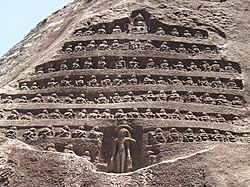Western Ganga literature

Western Ganga literature (
Kannada writings
| Kannada poets and writers in Western Ganga Kingdom (350–1000 CE) | |
| Durvinita | 529-579 |
| Chavundaraya | 978 |
| Gunavarma I | 900 |
| Ranna | 973 |
| Nagavarma I | 990 |
| Gunanandi | 9th century |
| Shivamara II | 800 |
The prose piece of
This writing states that along with the Tirthankaras, their mothers were also worshipped, particularly by women. The worship of Vaishravana, the keeper of celestial treasure was for acquiring moral and religious merit (punya), the worship of
The earliest known Kannada writer from this dynasty is King Durvinita of the 6th century. Kavirajamarga of 850 CE, refers to him as an early writer in Kannada prose.[8][9] It is claimed that the name Durvinita is found only in Kavirajamarga and Western Ganga inscriptions prior to the Magadi inscription of 966. This according to historians is proof enough that the Durvinita mentioned in Kavirajamarga is the Western Ganga king.[10]
Sanskrit writings
This was the age of classical Sanskrit literature. From the earliest times, Western Ganga kings showed a strong inclination towards the fine arts. King Madhava II (brother of King Vishnugopa) wrote a treatise Dattaka Sutravritti on an earlier work on erotics by a writer called Dattaka. To King Durvinita is ascribed the Sanskrit version of Vaddakatha, a commentary on Pāṇini's grammar called Sabdavathara and a commentary on the 15th chapter of a Sanskrit work called Kiratarjunneya by poet Bharavi (who was in King Durvinita's court).[18] King Sripurusha wrote a treatise on elephants called Gajashastra and King Shivamara II is known to have written Gajamata Kalpana.[18]
Hemasena, also known as Vidya Dhananjaya authored Raghavapandaviya, a narration of the stories of Rama and the Pandavas simultaneously through puns.[19] His pupil Vadeebhasimha wrote in prose Gayachintamani and Kshatrachudamini based on poet Banas Kadambari[16] and minister Chavundaraya wrote Charitarasara.[2]
Notes
- ^ a b c d Narasimhacharya (1988), p18
- ^ a b c Kamath (2001), p45
- ^ a b Chopra, Ravindran, Subrahmanian 2003, p160
- ^ a b c Sastri (1955), p357
- ^ Kulkarni (1975) in Adiga (2006), p256
- ^ Adiga 2006, p264
- ^ Adiga (2006), p273
- ^ Sastri (1955), p355
- ^ Kamath (2001), p40
- ^ Narasimhacharya (1988), p2
- ^ Doniger (1993), p 281
- ^ kamath (2001), p50
- ^ Adiga (2006), p2
- ^ a b Sastri (1955), p356
- ^ Narasimhacharya (1988), p12
- ^ a b Kamath (2001), p50
- ^ Narasimhacharya (1988), p19
- ^ a b Kamath (2001), p49
- ^ Venkatasubbiah in Kamath (2001), p50
References
Book
- Kamath, Suryanath U. (2001) [1980]. A concise history of Karnataka : from pre-historic times to the present. Bangalore: Jupiter books. OCLC 7796041.
- Adiga, Malini (2006) [2006]. The Making of Southern Karnataka: Society, Polity and Culture in the early medieval period, AD 400-1030. Chennai: Orient Longman. ISBN 81-250-2912-5.
- Chopra, Ravindran, Subrahmanian, P.N., T.K., N. (2003) [2003]. History of South India (Ancient, Medieval and Modern) Part I. New Delhi: Chand publications. ISBN 81-219-0153-7.)
{{cite book}}: CS1 maint: multiple names: authors list (link - Narasimhacharya, R (1988) [1988]. History of Kannada Literature. New Delhi, Madras: Asian Educational Services. ISBN 81-206-0303-6.
- Nilakanta Sastri, K.A. (2002) [1955]. A history of South India from prehistoric times to the fall of Vijayanagar. New Delhi: Indian Branch, Oxford University Press. ISBN 0-19-560686-8.
- Doniger, Wendy (1993) [1993]. Purana Perennis: Reciprocity and Transformation in Hindu and Jain Texts. SUNY Press. ISBN 0-7914-1381-0.
Web
- Arthikaje. "The Gangas of Talakad". History of karnataka. OurKarnataka.Com. Retrieved 31 December 2006.
